
What is a pivot hinge?
A pivot hinge is the type of hinge used on pivot doors. This hinge consists of a pivot system and a top pivot that you often mortise inside the door.

A pivot hinge is very different from a regular butt hinge. Butt hinges are attached to the door frame and the side of the door. Pivot hinges are often mortised inside the top and bottom of the door, always on a vertical axis.
The placement of these pivot hinges defines what makes a pivot door unique. A pivot door is basically a pivoting panel that rotates on a spindle. This vertical axis transports the door’s weight down to the floor, whereas a door with butt hinges hangs onto the hinges.
How do pivot hinges work?
There are different types of pivot hinges that all work in different ways. One of those types is the spring-loaded pivot hinge. This type of hinge is simple and powered by a spring that is compressed when the door opens and released to close the door.
Another type of pivot hinge is the hydraulic pivot hinge. This type of system works with oil that moves inside the system according to the door’s movement.

The oil is pushed through small channels when the door opens, creating the exact right amount of resistance for the door to open smoothly without gaining too much speed. When the door closes, the oil flows back through these small channels, once again creating the exact right amount of resistance for the door to close smoothly at the right speed.
A hydraulic pivot hinge can have various features, made possible by the systems’ hydraulic technology.
Most pivot hinges offer various hold positions: positions in which the door will not open or close further when you hold the door still at that point. Depending on the type of door, the hold positions can be located at 90°, -90°, and 0°. 360° rotating doors or pivoting walls can benefit from pivot hinges that offer hold positions at every 45° on top of the standard 90° angles.
Soft close is more than just a luxury feature. Slamming doors can become quite a nuisance, especially when the doors are used often. In hydraulic pivot hinges, a soft close is created by building up a lot of oil pressure by narrowing the channels right before the door closes.
Some pivot hinges also offer a back-check, a feature that prevents the door from touching or slamming the adjacent wall, door, or furniture. This feature works in the same way as soft close.
Speed control is a rare feature found in only some pivot hinge systems. It allows you to determine the speed of the door throughout a part of the door’s movement. This adjustability can, for example, be found in FritsJurgens’ System M+ pivot hinge.
Finally, there’s latch control. This setting is mainly designed for exterior doors or doors with a latching bolt and gives the door extra speed at the end of the door’s movement. This helps to ensure that the door closes properly.
Are pivot hinges self-closing?
Yes, a pivot hinge can be self-closing depending on the type of hinge you choose. FritsJurgens offers various self-closing pivot hinge systems, such as System M+.
What are the benefits of pivot hinges?
One of the main benefits of a pivot hinge is the design freedom that it offers.
Thanks to the pivot hinges that carry them, pivot doors can be much larger than standard hinged doors. You can design oversized pivot doors that measure 23 feet tall and 6.5 feet wide. You’re not bound to the standard measurements of traditional doors.

The location of the pivot hinge also allows pivot doors to be much heavier than standard hinged doors. A regular door hangs onto the door frame on one side. The weight of a too-heavy traditional hinged door will ultimately damage the hinges, the door, or the frame.
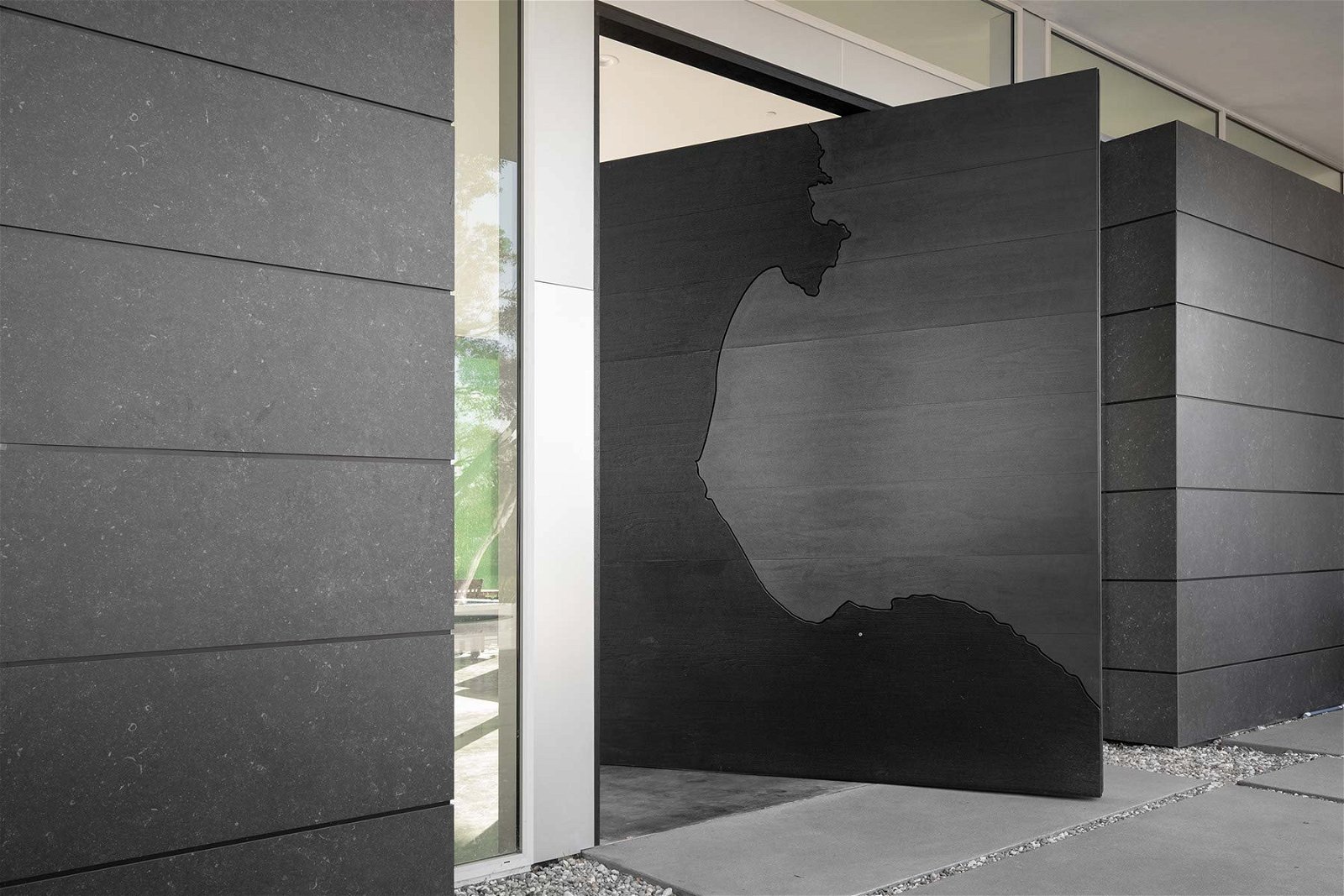
The weight of a pivot door is much better distributed. The load is distributed through the pivot hinge and into the floor without pulling onto the door’s frame. Door frames are even redundant.
This freedom in measurements and weight creates tremendous freedom indoor materials. Both interior and exterior pivot doors can be made out of almost any thinkable material, from wood and steel to copper and marble.

Another advantage of a pivot hinge is the fact that it’s hidden. There are various types of pivot hinges, but when you choose a type that is mortised inside the door, only a tiny floor- and ceiling plate are visible. Some brands, like FritsJurgens, even have these plates in various designs. This way, all the attention can go to the door and its design, and the hinges don’t cause unnecessary distractions.

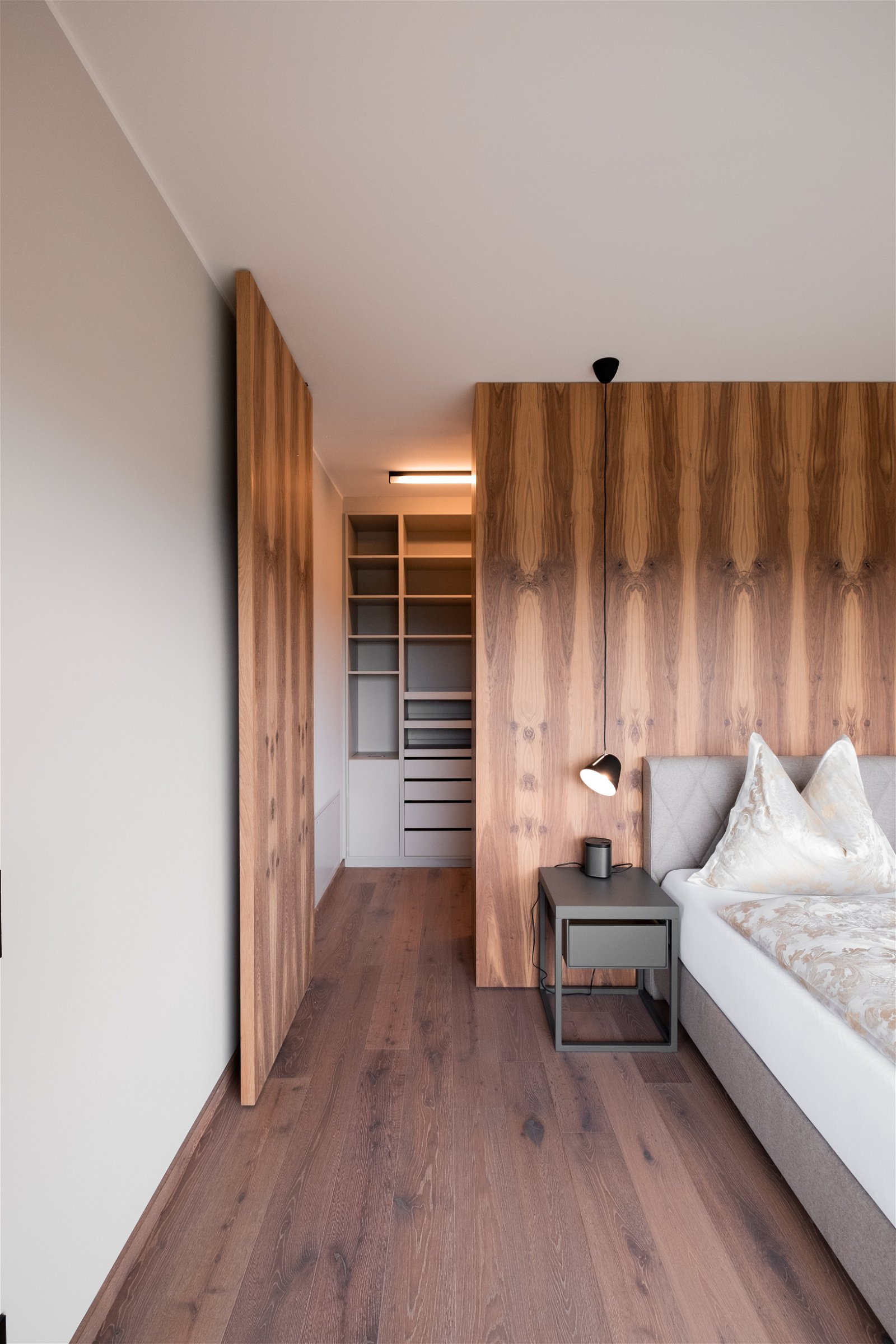
Hidden door with hidden pivot hinges by FritsJurgens - Manufactured by Breitenthaler. Photography by Elena Egger
A pivot hinge is applicable in almost every type of situation. Whether it’s an exterior door or an interior door in a new or an existing situation, a pivot hinge and door are a great solution.
There are pivot hinges on the market that can take all types of circumstances—hot or cold or very dry or wet. There are various certificates for different types of corrosion resistance that you can check if you doubt the hinge suits your situation.

How much weight can a pivot hinge hold?
A pivot hinge can hold around 20 – 500 kg. This depends on the type of pivot hinge you choose. FritsJurgens’ pivot hinges can carry doors weighing between 20 and 500 kg, based on your door’s design.
Which door hinge supports the most weight?
FritsJurgens’ System M+ is the door hinge that supports the most weight. This hinge can carry doors that weigh up to 500 kg, while effortlessly controlling the door’s movement.
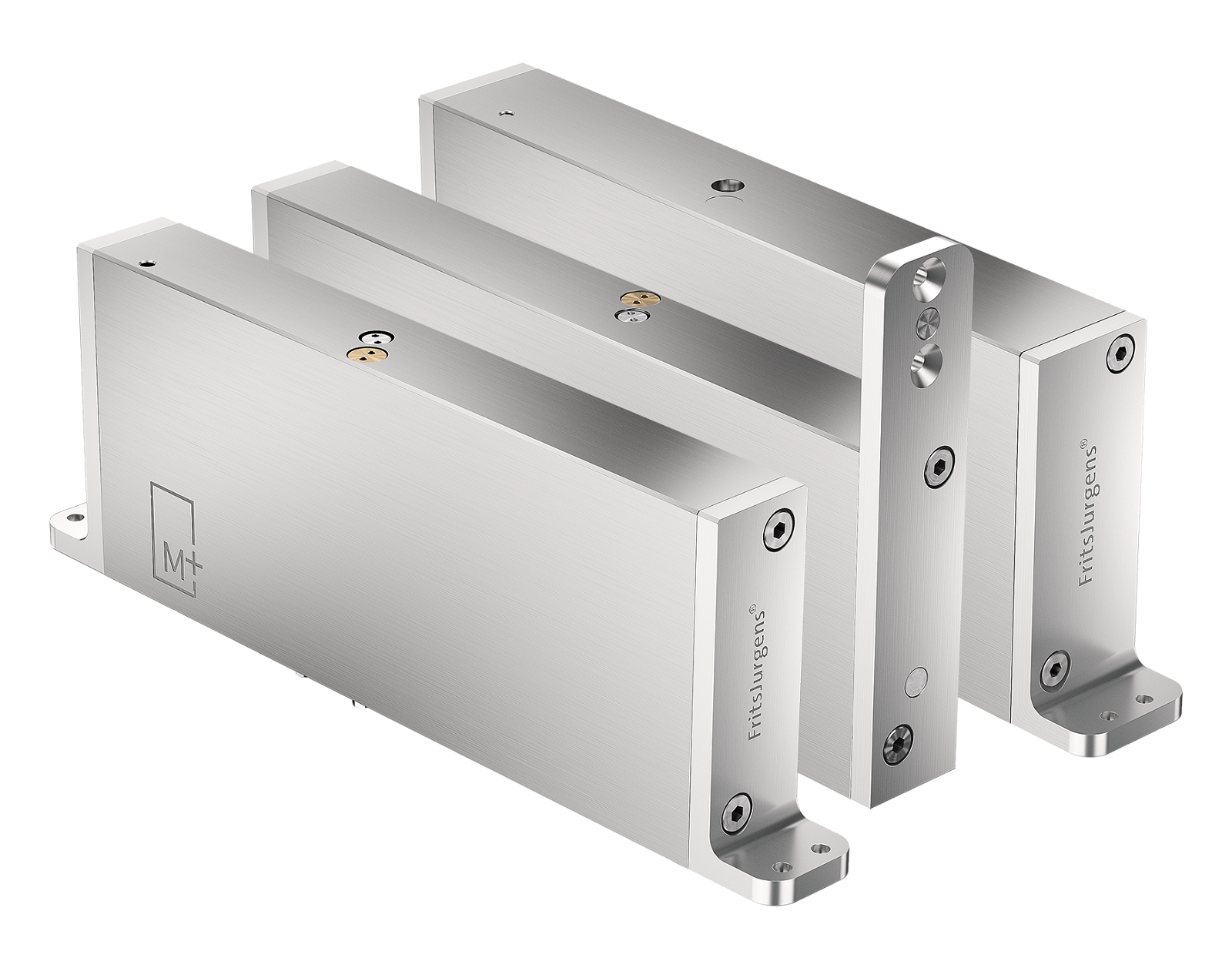
What types of pivot hinges are there?
There are various types of pivot hinges, such as spring-loaded hinges and hydraulic hinges. There are pivot hinges that need to be mortised in the floor. Others are mortised inside the door.
We already touched upon the difference between spring-loaded pivot hinges and hydraulic pivot hinges earlier.Spring-loaded hinges are powered by a spring, while oil flows inside the system power hydraulic pivot hinges.
One way to apply a pivot hinge is by digging or drilling a large hole in the floor for an in-floor pivot hinge.
An in-floor pivot hinge takes planning ahead. The system must be placed before the final floor is installed.
Once the pivot hinge is placed inside the floor, no more adjustments are possible. This is a risk because if the door is not correctly in place, it can create friction with adjacent walls, floors, or ceilings or even get stuck.
This type of system can be expensive, not because of the system itself, but because of the many days of labor necessary on-site to install the pivot hinge and the door.
Once the door is installed with an in-floor pivot hinge, a large cover plate will stay visible on the floor. Even when the plate is filled with the final floor, the outline of the plate will remain visible.
An in-door pivot hinge offers much more freedom and a lot less drilling.
The top pivot and pivot system are mortised respectively in the top and bottom of the door. This does not have to happen on site.
On-site, only the floor- and ceiling plate must be placed. Then the door is lifted into space. Depending on the pivot hinge brand, this process takes a few hours up to an astounding 30 minutes with a brand like FritsJurgens. Discover how to install a pivot door fast.
The quality of pivot hinges is different per brand. It is worth taking a good look at what features your pivot hinge should have and to keep in mind that a door is not something you buy or design for the short term. A good, high-quality pivot hinge carries your door effortlessly without maintenance for at least ten years.
Some pivot hinges are specifically right-handed or left-handed. This means that this hinge is suitable for doors that open either on the right or the left side. Most hinges, however, can be placed at any desired position in the door. Right or left, or even in the middle of the door when it is very wide.
A pivot hinge can be double-acting when you’re not applying door frames. This means that the door can be opened from both sides. This highly benefits the ease and comfort with which the door is used.
When would you use a pivot hinge?
A pivot hinge can be used in almost every thinkable type of door and place. Both interior and exterior applications are possible in new and existing situations in residential and commercial buildings.
A pivot door can be a comfortable and stylish addition to the interior.
What can you design with a pivot hinge?
Pivot hinges can be applied in numerous types of ways. The design freedom is limitless. Besides the various kinds of door possibilities, pivot hinges can be used in very surprising ways.
When applying one pivot hinge, why not use multiple? Pivoting walls are excellent room dividers that are beautiful, comfortable, and adjustable.

A great example of an ingenious pivot door design is this pivoting bookcase. The high load-bearing capacity of the applied pivot hinge easily carries this bookcase that doubles as a tv-cabinet.

In-door pivot hinges lend themselves well to hidden passages. Thanks to the way they’re mortised – hidden away in the door – they’re invisible.

When you go for a compact type of pivot hinge, it can be applied in very thin doors. In this case, pivoting louvers can separate the hall from the dining at any time.
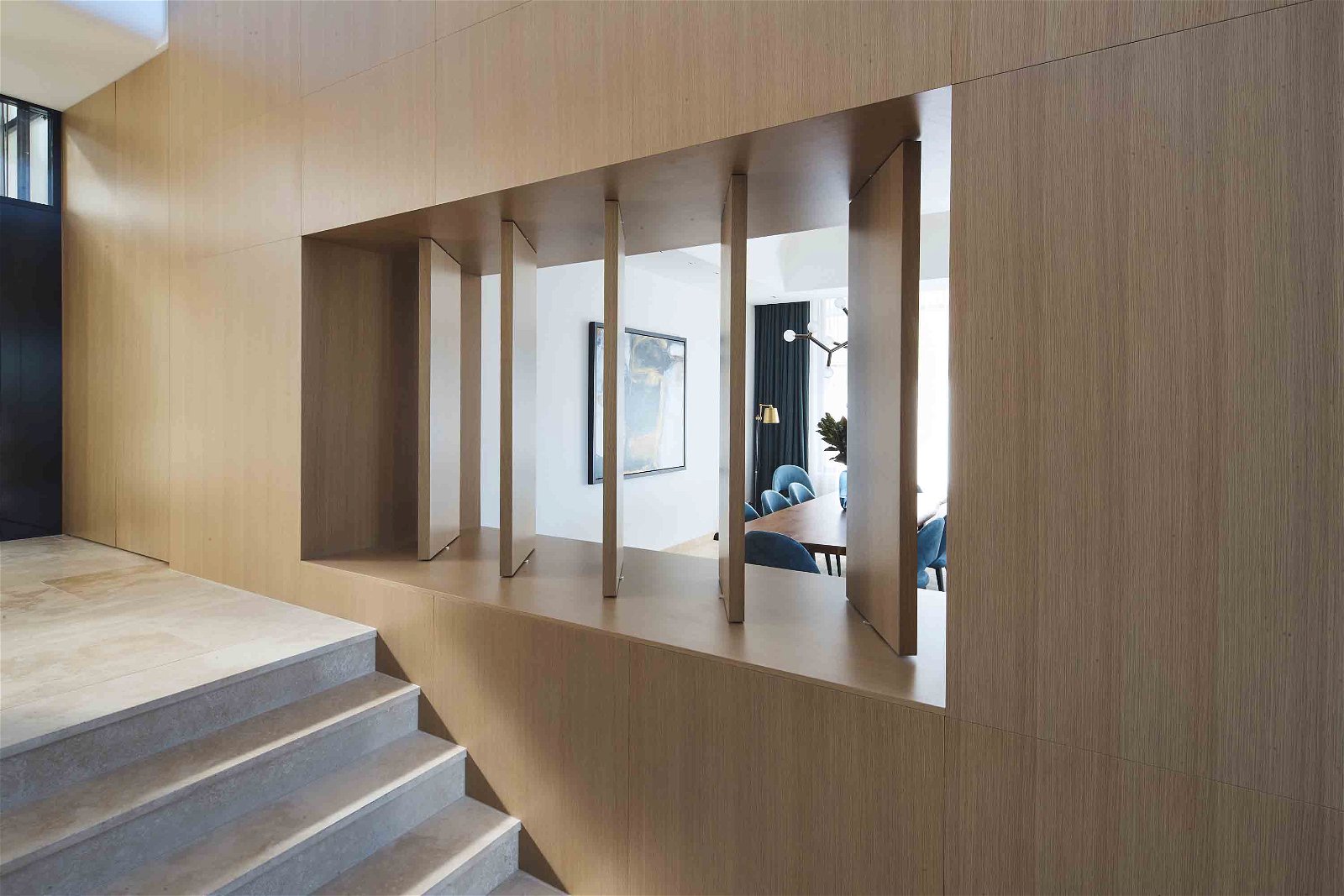
Another way to apply a pivot hinge is in a cupboard door. This one subtly hides a murphy bed.


The door that hides a murphy bed – Designed by Nabi Boyd
It might seem obvious, but pivoting windows are another possible application of a pivot hinge.

How do I install pivot hinges?
A pivot hinge is installed in four steps: installing the system inside the door, securing the floor- and ceiling plate, lifting the door into place, and fine-tuning the door’s position and movement.
First, the correct recess is created at the top and bottom of the door. The top pivot and pivot hinge are secured.
On-site, the floor- and ceiling plates are placed. These plates will hold the door in place.
Then the door can be lifted into position. The spindle in the top pivot is turned upwards, securing the door.
Finally, the door’s position and, depending on the pivot hinge system, the door’s movement can be fine-tuned.
Take a look at FritsJurgens’ full installation video or our installation blog for more information.
What pivot hinge should I buy?
If you buy a pivot hinge, it is essential to know what type of door you’re making and what functionalities this door needs.
How large and heavy is your door? Is it an exterior or an interior door? Will you apply door frames, and do you want to be able to perfect the door’s movement?
FritsJurgens has created a tool that helps you find the right pivot hinge for your door, FritsJurgens Tools. All you should know are your door’s measurements and weight.
Remember what type of installation procedure you prefer and what you want to spend money on. Quality hinges will prevent maintenance and errors, both short- and long-term.
Make sure you’re well advised. If you’re unsure what type of pivot hinge or even what type of door you want or need, feel free to contact FritsJurgens. FritsJurgens’ professionals have many years of experience assisting all kinds of pivot door projects.








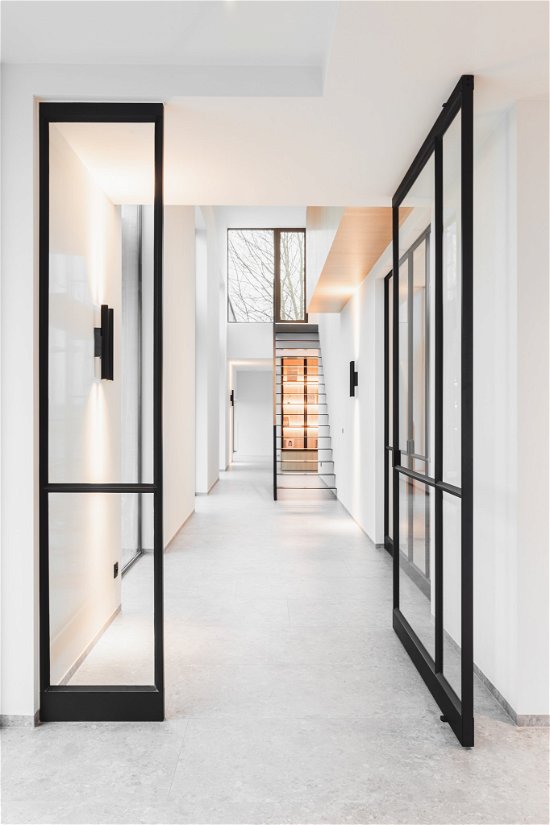


naaro_04.jpg?width=550)


